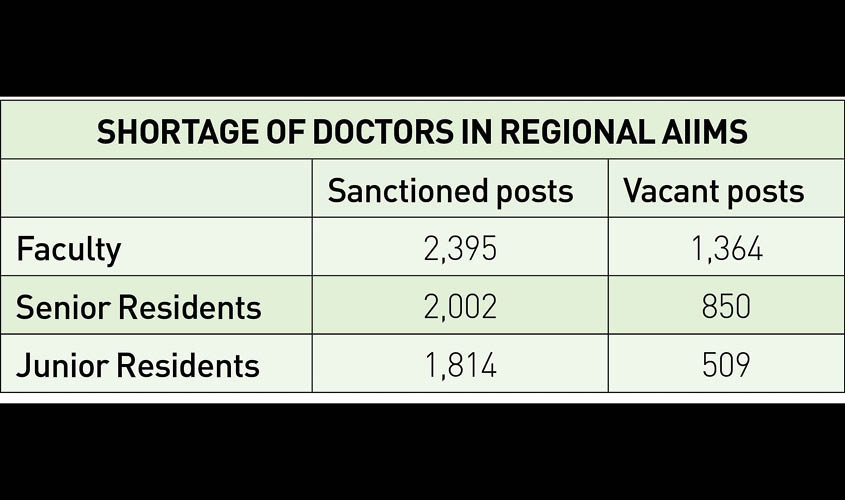New Delhi: The regional AIIMS (All India Institute of Medical Sciences), set up all over the country with an objective to provide best tertiary healthcare services, are facing an acute shortage of doctors.
According to the latest information provided by the Ministry of Health and Family Welfare, the 10 regional AIIMS—Bhopal, Bhubaneswar, Jodhpur, Patna, Raipur, Rishikesh, Mangalagiri, Nagpur, Kalyani, Raebareli—are facing a 57% shortage of doctors. Against the total sanctioned strength of 2,385 for faculty positions, these institutions have 1,031 doctors, while 1,364 posts are lying vacant. The situation is not good even for Senior Resident and Junior Resident posts. Against the sanctioned strength of 2,002 for Senior Residents, these regional AIIMS have only 1,152 doctors, while 850 posts are lying vacant. In case of Junior Residents, out of sanctioned 1,814 posts, there is a vacancy of 509.
In case of AIIMS in the national capital, the situation is worse. The hospital is facing a 34% shortage of faculty doctors. There are only 670 faculty doctors working at present against the sanctioned strength of 1,042, thus thre is a vacancy of 362 posts. Besides the faculty doctors, 958 Junior Residents and 1,350 Senior Residents are working for patient care in the premier health institution. The institution has appointed 56 faculty doctors in the grade of assistant professor on contractual basis to deal with the problem of shortage. In order to tide over the crisis, the government has sanctioned 305 posts of various faculty disciplines for each of the six functional AIIMS at Bhopal, Bhubaneswar, Jodhpur, Patna, Raipur and Rishikesh. As many as 183 faculty posts have been sanctioned for each of the AIIMS at Mangalagiri, Nagpur and Kalyani. Posts of Senior Residents and Junior Residents have also been sanctioned for each of these AIIMS.
The issue was raised in the ongoing session of the Lok Sabha. Replying to a question on the issue, Minister of State for Health Ashwini Choubey said: “Vacant faculty posts are advertised regularly by the institutes depending on their requirement. However, as high standards have to be maintained in selection, keeping in view the status of these institutes of national importance, all the advertised positions could not be filled.”
“In order to facilitate expeditious filling up of vacancies, separate standing selection committees have been constituted for each of the six AIIMS. Also, the government is carrying out recruitment exercises periodically in all the six AIIMS,” he said.
The idea of opening AIIMS level institutes in different parts of the country was mooted with the objective of correcting regional imbalances in the availability of affordable and reliable tertiary healthcare services and also to augment facilities for quality medical education in the country. The move was aimed at creating AIIMS-like facilities in states so that people do not have to come all the way to Delhi AIIMS for treatment.
In the 2004-05 interim budget, the Vajpayee-led NDA government had first announced for setting up six regional AIIMS in Bihar, Chhattisgarh, MP, Orissa, Rajasthan and Uttaranchal (now Uttarakhand). It was also proposed to upgrade one medical college each in Andhra Pradesh, Jammu & Kashmir, Jharkhand, Tamil Nadu, UP, and West Bengal, to the level of AIIMS.
Soon after coming to power in 2014, the Narendra Modi government decided to revive the earlier effort of opening regional AIIMS. In the Union Budget for 2015-16, six new

